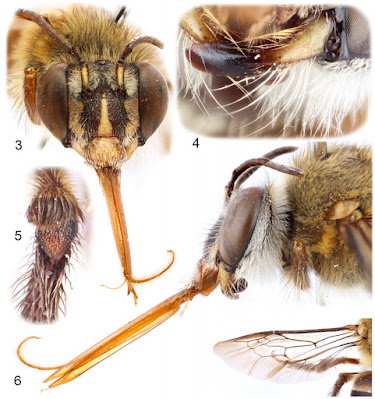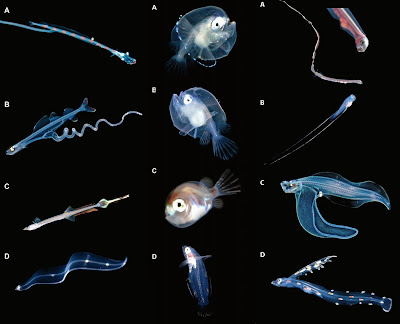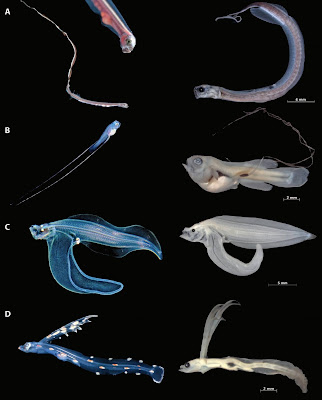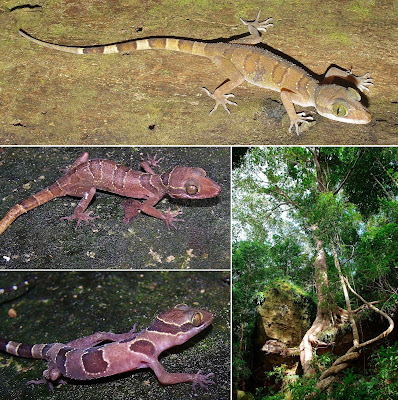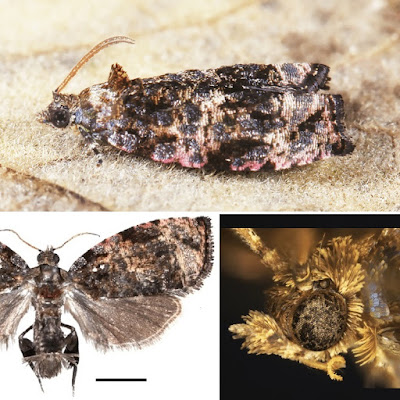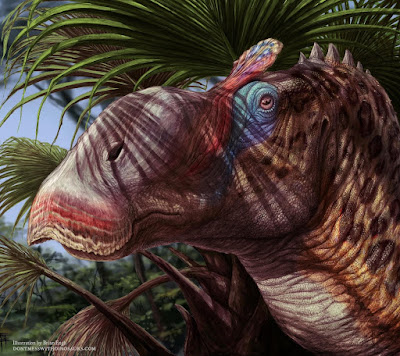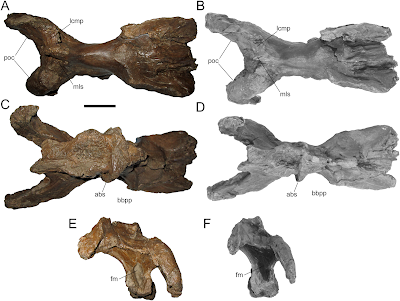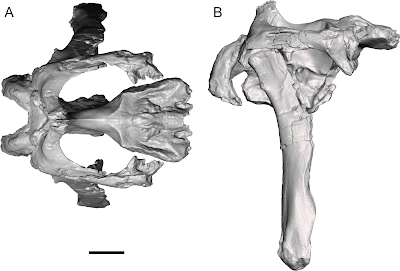[Most Recent Entries] [Calendar View]
Saturday, April 3rd, 2021
| Time | Event | ||||||||||
| 9:13a | [Ichthyology • 2021] Redescription of the Guiana Shield Darter Species Characidium crandellii and C. declivirostre (Characiformes: Crenuchidae) with Descriptions of Two New Species: Characidium duplicatum & C. wangyapoik
Abstract Based on collections made in the western Guiana Shield over the last 21 years, Characidium crandellii and C. declivirostre are redescribed and two similar species are described from Guyana. These species all have enlarged paired fins with three to four rays thickened ventrally on the pectoral fin and two rays thickened on the pelvic fin. The species can be separated from all other Characidium and Melanocharacidium by having the venter unscaled from the isthmus to the pelvic origin. Characidium crandellii is found in the Essequibo and Takutu River systems and in an isolated population above Tencua Falls in the Ventuari River and the upper Paragua River (Orinoco River basin). Characidium declivirostre is found throughout the right-bank, shield tributaries of the Orinoco River system and in the upper Negro River. Characidium duplicatum, new species, appears to be rare but widely distributed in the Essequibo River system. Characidium wangyapoik, new species, is only known from the upper Ireng River, Branco River basin, along the border between Brazil and Guyana. Characidium crandellii Steindachner, 1915 Characidium declivirostre Steindachner, 1915 Characidium duplicatum, new species Distribution.—(Fig. 9) Found throughout the Essequibo River basin, but has been rarely encountered during our surveys. Most locations are in the lower Potaro and Kuribrong, but two localities are in the upper Essequibo upstream of the mouth of the Kuyuwini River. Etymology.—Duplicatum is Latin for double and is a neuter adjective. In reference to the presence of two unbranched anal-fin rays. 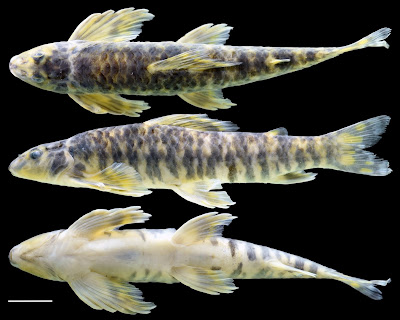 Characidium wangyapoik, new species Distribution.—(Fig. 9) Characidium wangyapoik is only known from the upper Ireng River basin (Amazon River) along the Brazil/Guyana border (known as the Rio Mau in Brazil). Specimens were collected from below Orinduik Falls to the upper falls on the Ireng and its equal tributary, the Sukwabi River, but not above the Uluk Tuwuk or Wotawanda falls of the upper Ireng and Sukwabi Rivers (see Lujan et al., 2020, for a more detailed map and description of this area). Etymology.—Wangyapoik is the Patamona word for the species, and it is used as a noun in apposition. Wang means ‘honey' and yapoik means ‘seated,’ perhaps in reference to the yellowish color. The Patamona also refer to the species by the English common name of “fallsfish.” Jonathan W. Armbruster, Nathan K. Lujan and Devin D. Bloom. 2021. Redescription of the Guiana Shield Darter Species Characidium crandellii and C. declivirostre (Crenuchidae) with Descriptions of Two New Species. Ichthyology & Herpetology. 109(1); 102-122. DOI: 10.1643/i2019299 | ||||||||||
| 9:39a | [Entomology • 2018] Varthemapistra edentata • A New Genus of Anthophorine Bees (Hymenoptera: Apidae) from Brunei
Abstract A new genus of anthophorine bees (Apinae: Anthophorini) is described and figured from a remarkable female collected in eastern Brunei (northern Borneo). Varthemapistra edentata Engel, new genus and species, is most similar to species of Habrophorula Lieftinck, which occur in southeastern China, and Elaphropoda Lieftinck, found broadly across Southeast Asia. Habrophorula and the new genus both have the third submarginal cell broad anteriorly and posteriorly. Unique among anthophorines, V. edentata has a simple female mandible, while other Anthophorini have bidentate or tridentate mandibles. The genus is described and figured, and a revised key to the genera of Anthophorini provided. Keywords: Anthophila; Apoidea; Apidae; Apinae; Anthophorini
Tribe Anthophorini Dahlbom Varthemapistra Engel, new genus Diagnosis: The new genus can be distinguished in the female from other anthophorines by the simple mandible, lacking any preapical teeth (Fig. 4) (note that this is not the result of mandibular wear: vide etiam Discussion, infra). In addition the combination of a weakly protuberant clypeus, linear malar space, metatibia with setae on outer surface distinctly fuscous medially, and forewing with the anterior border of the third submarginal cell only slightly shorter than the posterior border further serve to char-acterize the genus among other Anthophorini, in the female sex. Etymology: The new generic name is a combination of Varthema; after Ludovico di Varthema (1470–1517), the Italian explorer who, among other things, was apparently the earliest to record accounts of Brunei based on his possible visit to the then Empire in 1505 (Temple, 1928: it should be noted, however, that while his account accords with a visit to Brunei, he may have landed elsewhere on Borneo and learned trade details from other ports on the island, e.g., Vienne, 2015); and the Latin apis (meaning, “bee”), and –istra, the diminutive suffix referencing “wild resemblance”. The gender of the name is feminine. Varthemapistra edentata Engel, new species Etymology: The specific epithet refers to the absence of preapical teeth on the fe-male mandible. Michael S. Engel. 2018. A New Genus of Anthophorine Bees from Brunei (Hymenoptera: Apidae). Journal of Melittology. 78; 1–13. DOI: 10.17161/jom.v0i78.7488 | ||||||||||
| 9:43a | [Ichthyology • 2021] Blackwater Diving: An Exciting Window Into the Planktonic Arena and Its Potential to Enhance the Quality of Larval Fish Collections
Abstract “Blackwater diving,” or nighttime SCUBA diving in epipelagic environments, has become highly popular in recent years because lay participants encounter animals that are difficult and expensive to observe through other methods. These same observations can be priceless for researchers working with these species, so an interface between the scientific communities and recreational divers would be mutually beneficial. In this paper, we describe one such interface through the photography, collection, and DNA barcoding of larval fishes from the island of Hawaii. The images and videos from this activity provide an exciting window into the epipelagic environment and the way larval fishes appear and swim within it. Blackwater diving allows us to see the often-elaborate appendages and other specializations of these larvae as they appear in situ, prior to extensive net and fixation damage. However, blackwater diving remains an almost exclusively recreational pursuit, particularly popular among underwater photographers, who have little interest in (or object to) collecting specimens for scientists. Nonetheless, a logical next step is careful hand collection of specimens for scientific study. Growing numbers of recreational divers around the world have access to an otherwise expensive-to-research habitat. Here we present, for the first time, in situ and post-fixation photos of larval fishes that were hand collected and fixed in 95% ethanol by blackwater divers operating out of Kona, Hawaii, with DNA barcode identifications congruent with morphology and pigmentation where possible. With the right motivation, blackwater diving could augment research in the pelagic ocean and significantly enhance natural history collections and our knowledge of the larvae of marine fishes. Ai Nonaka, Jeffrey W. Milisen, Bruce C. Mundy and G. David Johnson. 2021. Blackwater Diving: An Exciting Window Into the Planktonic Arena and Its Potential to Enhance the Quality of Larval Fish Collections. Ichthyology & Herpetology. 109(1); 138-156. DOI: 10.1643/i2019318 | ||||||||||
| 10:01a | [Herpetology • 2021] Cyrtodactylus kulenensis • Molecular Phylogenetics, PCA, and MFA recover A New Species of Cyrtodactylus (Squamata: Gekkonidae) from An isolated Sandstone Massif in northwestern Cambodia Abstract The integrated results of maximum likelihood (ML) and Bayesian inference (BI) analyses, principal component analyses (PCA), and a multiple factor analysis (MFA) recover a new, widely allopatric species of the Cyrtodactylus intermedius species group. Cyrtodactylus kulenensis sp. nov. is endemic to the Phnom Kulen sandstone massif of the Phnom Kulen National Park, Siem Reap Province, in the lowlands of northwestern Cambodia. A phylogenetic analysis from a short read (275 base pairs) of the mitochondrial gene NADH dehydrogenase subunit 2 (ND2) from C. kulenensis sp. nov. was aligned with 1449 base pairs from all other species in the intermedius group. The analysis recovered C. kulenensis sp. nov. as the sister species to a lineage composed of populations from the widely separated hilly regions of Sa Keao and Sakaerat in eastern Thailand. Multivariate (PCA, DAPC, and MFA) and univariate analyses (ANOVA) using combinations of meristic (scale counts), mensural (morphometric), and categorical (color pattern and morphology) characters from 52 specimens encompassing all species of the intermedius group clearly demonstrate C. kulenensis sp. nov. is significantly different and discretely diagnosable from all other species in the intermedius group. This new discovery further highlights the herpetological diversity and high levels of range-restricted endemism in basin-habitat-island landscapes throughout Indochina and the continued need for field work in the landscapes that remain unsurveyed. Keywords: Reptilia, gecko, habitat island, phylogeny, Indochina, systematics, Siem Reap Province, Phnom Kulen National Park
Cyrtodactylus kulenensis sp. nov.
L. Lee Grismer, Peter Geissler, Thy Neang, Timo Hartmann, Philipp Wagner and Nikolay Poyarkov. 2021. Molecular Phylogenetics, PCA, and MFA recover A New Species of Cyrtodactylus (Squamata: Gekkonidae) from An isolated Sandstone Massif in northwestern Cambodia. Zootaxa. 4949(2); 261–288. DOI: 10.11646/zootaxa.4949.2.3 | ||||||||||
| 10:13a | [Entomology • 2020] Ukamenia thailandica • Ukamenia Oku, 1981 (Lepidoptera: Tortricidae: Olethreutinae), New Record for Thailand with Descriptions of A New Species
Abstract The genus Ukamenia Oku, 1981 is recorded the first time for Thailand and a new species, Ukamenia thailandica n. sp., is described. Photograph of living specimens of U. thailandica n. sp. in natural resting posture is present. The one new taxon increases the number of described Ukamenia species to 4. Keywords: new species, Olethreutini, Thailand
Ukamenia thailandica n. sp. Diagnosis. This species is most similar to Ukamenia sapporensis (Matsumura, 1931) but male genitalia of U. thailandica n. sp. differs by a pair of subelliptical pouch on abdominal sternum III (subcircular in U. sapporensis), sacculus projecting lobe shorter than mid length of valva (longer than mid length of valva in U. sapporensis), and subcone-shaped phallus (subcylindrical in U. sapporensis). Sopita Muadsub and Nantasak Pinkaew. 2020. Ukamenia Oku, 1981 (Lepidoptera: Tortricidae: Olethreutinae), New Record for Thailand with Descriptions of A New Species. Zootaxa. 4881(1); 83–90. DOI: 10.11646/zootaxa.4881.1.5 | ||||||||||
| 10:54a | [Paleontology • 2021] Ornatops incantatus • A New Brachylophosaurin (Dinosauria: Hadrosauridae) from the Upper Cretaceous Menefee Formation of New Mexico
Abstract Brachylophosaurini is a clade of hadrosaurid dinosaurs from the Campanian of western North America. Although well-known from northern localities in Montana and Alberta, including abundant material of Brachylophosaurus canadensis and Maiasaura peeblesorum and the holotypes of Acristavus gagslarsoni and Probrachylophosaurus bergei, material from southern localities in Utah and Colorado is restricted to a partial skull referred to A. gagslarsoni and several indeterminate specimens. Here we describe Ornatops incantatus gen. et sp. nov., a new brachylophosaurin known from a partial skeleton from the Allison Member of the Menefee Formation in New Mexico. Ornatops is the first brachylophosaurin reported from New Mexico and the southernmost occurrence of the clade. Ornatops shares with Probrachylophosaurus and Brachylophosaurus a caudally expanded nasofrontal suture on the frontals, but also exhibits an autapomorphic nasofrontal suture morphology, with a horizontal rostral region and elevated caudal region with two prominent parasagittal bumps, which is different from other brachylophosaurin specimens, including juvenile and adult Brachylophosaurus. A phylogenetic analysis places Ornatops in a trichotomy with Probrachylophosaurus and Brachylophosaurus, with Maiasaura and Acristavus as successive outgroups. Systematic paleontology Dinosauria Owen, 1842, sensu Baron, Norman & Barrett, 2017 Ornithischia Seeley, 1888, sensu Sereno, McAllister & Brusatte, 2005 Ornithopoda Marsh, 1881, sensu Butler, Upchurch & Norman, 2008 Iguanodontia Baur, 1891, sensu Sereno, McAllister & Brusatte, 2005 Hadrosauridae Cope, 1869, sensu Prieto-Márquez, 2010a Saurolophinae Brown, 1914, sensu Prieto-Márquez, 2010a Brachylophosaurini Gates et al., 2011, sensu Freedman Fowler & Horner, 2015 Ornatops incantatus gen. et sp. nov. Holotype: WSC 10058, associated skeleton including the partial right premaxilla, right postorbital, right squamosal, both quadrates, nearly complete skull roof and braincase, two partial dorsal vertebrae, a dorsal rib, ossified tendons, the right scapula, proximal end of the right humerus, right ulna lacking the proximal end, right radius lacking the proximal end, right metacarpals II and III, and incomplete pubis and ischium. While this article focuses on the cranial bones, the rest of the specimen will be completely described in a forthcoming publication (A.T. McDonald et al., 2021, in preparation). Etymology: Ornatops is derived from the Latin word ornatus (ornate) and the Greek ops (face), in reference to the elaborate nasofrontal suture. The species name, incantatus, is a Latin word meaning “enchanted”, referring to the State of New Mexico, where the holotype was collected and which carries the motto “Land of Enchantment”. The binomen can be translated as “enchanted ornate face”. Locality: WSC 10058 was collected in San Juan County, New Mexico, on land administered by the United States Bureau of Land Management (BLM). Precise locality data are on file at WSC and the BLM. Horizon: WSC 10058 was collected at a single locality in the Juans Lake Beds (Miller, Carey & Thompson-Rizer, 1991), upper part of the Allison Member, Menefee Formation, approximately 120 meters below the overlying Cliff House Sandstone; middle Campanian, Upper Cretaceous, older than ~78.5 Ma based upon the occurrence of the ammonite index fossil Baculites perplexus in the overlying Cliff House Sandstone (Siemers & King, 1974; Molenaar et al., 2002; Lucas et al., 2005). Specific diagnosis (as for genus by monotypy): brachylophosaurin distinguished by a single autapomorphy: nasofrontal suture on dorsal surface of frontals is horizontal rostrally and elevated caudally, ending in a pair of parasagittal bumps adjacent to the cranial midline. Furthermore, the nasofrontal suture extends caudally onto the dorsal surface of the frontals farther than in adult Probrachylophosaurus bergei, but not as far as in adult Brachylophosaurus canadensis. Conclusions: Ornatops incantatus is a new genus and species of brachylophosaurin hadrosaurid known from the holotype partial skeleton from the Allison Member of the Menefee Formation in New Mexico. The morphology of the caudally expanded nasofrontal suture in O. incantatus indicates that it is closely related to and possibly intermediate between Probrachylophosaurus bergei and Brachylophosaurus canadensis, although additional material is necessary to fully explore the evolution of brachylophosaurins in southern Laramidia. The expanded nasofrontal suture of O. incantatus indicates the presence of a solid nasal crest, similar to P. bergei and B. canadensis, although the shape of the crest is unknown. O. incantatus is the first crested brachylophosaurin found in southern Laramidia, illustrating the potential of the Menefee Formation to inform future studies on dinosaur evolution in North America during the Campanian. Andrew T. McDonald, Douglas G. Wolfe, Elizabeth A. Freedman Fowler and Terry A. Gates. 2021. A new brachylophosaurin (Dinosauria: Hadrosauridae) from the Upper Cretaceous Menefee Formation of New Mexico. PeerJ. 9:e11084. DOI: 10.7717/peerj.11084 |
| << Previous Day |
2021/04/03 [Calendar] |
Next Day >> |




